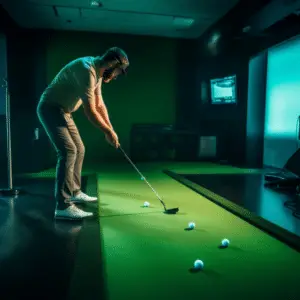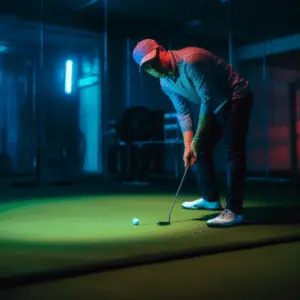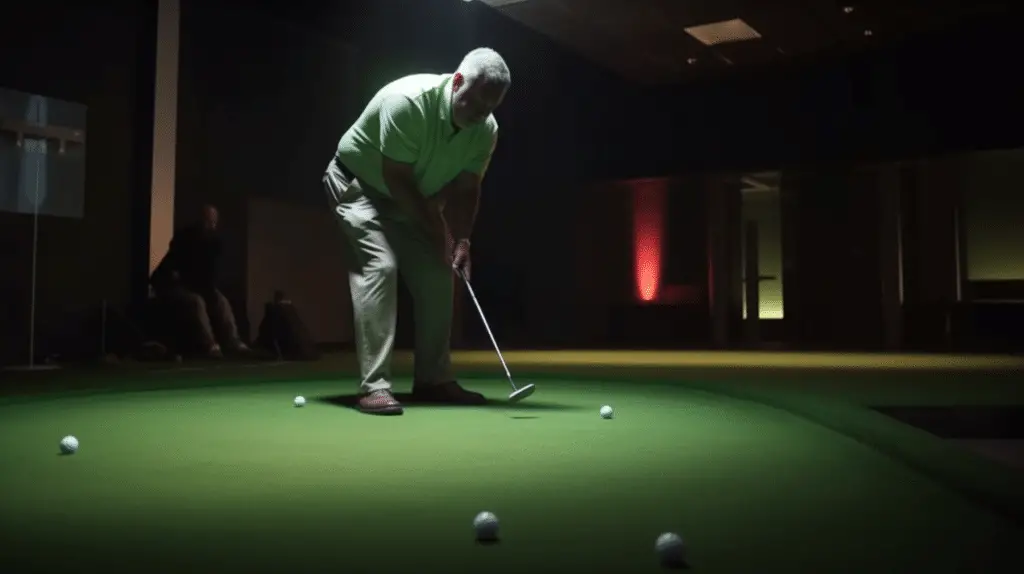Last Updated on June 12, 2023
Golf is one of the greatest sports in the world, enjoyed by millions of players around the globe. If you’ve ever wanted to know how to putt on a golf simulator, then this article is perfect for you! Putting is an integral part of any golfer’s game, and getting it right can make all the difference when out on the course. Here we’ll outline some essential tips and tricks to help you get up-to-speed with putting on your simulator set-up as quickly as possible. So don’t delay – read on and find out what you need to do to master that tricky art of putting!
Setting Up The Room For Putting
When setting up a golf room for putting on a simulator, there are some essential steps to take. Firstly, one needs to be sure the space is suitable: it should have enough area and headroom to accommodate the golfer while they play. It’s also important to make sure the flooring is stable and cushioned – this will help with shock absorption of any impacts from hitting balls off the tee.
Secondly, it’s vital that an appropriate putting setup is chosen for the simulator. This could include items such as a mat or artificial turf surface, which can provide more accurate feedback when playing shots. Additionally, having certain tools like alignment sticks or training aids may help improve your game. Finding what works best for you in terms of equipment and accessories can go a long way towards making your practice sessions enjoyable and effective.
Equipment Needed For Putting
The main item required is a putting mat; this will act as the surface upon which you’ll be attempting your putts. A golf simulator system may also prove useful if you want to track and monitor your performance in greater detail. Many of these systems come with different types of putting green, allowing you to practice on different surfaces that are closer to replicating those found outdoors – such as rough or bent grass. You can even buy mats designed specifically for use with golf simulators so that your experience feels more realistic. Alternatively, you could always lay down some real turf or carpet in lieu of a traditional putting mat. Whichever option you choose, make sure that it provides enough cushioning and grip when striking the ball. Doing this will ensure accuracy and consistency when practising your putting technique at home – all from the comfort of your own living room!
Selecting The Right Club
Selecting the right club is essential for successfully putting on a golf simulator. The best club to use will depend on your individual style of putting, but generally, it should be shorter than a regular golf club. A putter with a loft angle of between 2 and 5 degrees works well, as this allows you to control the speed and direction of the ball more easily. It’s also important that the grip fits comfortably in your hands so you can maintain a consistent swing throughout each stroke.
When selecting a putting club, look for one which has an even balance point between the head and shaft – this ensures there won’t be any jerky movements during your strokes. Additionally, make sure the weight of the head isn’t too heavy or light; it should feel comfortable when swinging without sacrificing accuracy or distance control. Finally, try out different clubs until you find one that feels ‘just right’ – then stick with it!
Techniques For Striking The Ball
When putting on a golf simulator, it is important to remember that the same principles and techniques apply to real-life golf. Here are some tips to help you strike the ball effectively when using a golf simulator:

First of all, make sure you have a good grip on the putter before taking your shot. To get an effective backswing, keep your arms straight and move them in one smooth motion away from your body. As you reach the top of the backswing, your wrists will naturally hinge slightly so that they can generate power into the downward swing towards the ball. After impact, follow through until both hands are pointing in line with where you want the ball to go. Keeping your head still throughout this process will also ensure accuracy when putting on a golf simulator.
To improve consistency while playing on a golf simulator, practice different types of shots, such as draw or fade shots. Draw shots require extra wrist action during contact with the ball, which causes it to curve left (for right handed players). Fade shots involve less wrist action causing it to curve right (for right handed players). By mastering these two basic shots, you’ll be able to better control where and how far you hit each putt on a golf simulator.
Strategies For Controlling Direction
When putting on a golf simulator, controlling the direction of your putt is key to achieving success. To do this effectively and consistently, there are several strategies you can employ.
Putt Aiming:
- Visualise the line: Before taking your stroke, take a few moments to visualise where you want the ball to roll. Look at the terrain around the hole and consider how it might affect your shot. This will give you a better sense of aim before starting to swing.
- Check your alignment: Make sure that you’ve got your feet aligned correctly, with both pointing towards the target when you address the ball. Doing so ensures that any variance in the club face angle won’t influence the outcome of your putts.
Putt Direction:
- Maintain consistency in equipment setup: If possible, use consistent grip pressure and length during each successive putt as these small variations can greatly impact accuracy and distance control over longer distances. Ensure that all other elements, such as stance width, ball positioning etc remain constant too for optimal results.
- Read greens accurately: When playing on an indoor golf simulator reading greens becomes even more important because virtual courses rarely have undulations or slopes like real-life courses have. Spend time familiarising yourself with green patterns and their effects on ball speed, acceleration, and trajectory – mastering this skill will help improve directional control significantly.
By using these strategies together, you should be able to get a good understanding of what is required to make successful shots every time while putting on a golf simulator. With practice comes perfection – keep honing your skills until they become second nature!
Troubleshooting Common Issues

The most common types of putt mishits are usually slices, hooks and shanks. A slice is when your ball curves off to the side during your putt; a hook is where it curves too far in one direction; and a shank is where the ball veers off sharply from its intended path due to contact with the heel or toe of your clubface.
To avoid these types of errors, check that you have chosen the right type and size of putter for your build and height, as well as make sure that it fits comfortably in your hands. When setting up your shot, be mindful not to over-rotate your shoulder and hips – this can often cause an error in aim. Furthermore, make sure there’s no tension in either arm before striking the ball; many players try to use their arms instead of relying on their body weight to drive through impact, which often results in inaccurate shots. Finally, ensure that you maintain a consistent tempo throughout each swing so that all parts move together without interruption for optimum control over accuracy.
Frequently Asked Questions
Are There Any Specific Putting Drills I Can Do On A Golf Simulator?
When it comes to improving one’s game, putting drills can be a valuable tool. And for those who have access to a golf simulator, there are various putting drills that they can use to help hone their skills and give them an edge on the greens. These drills are designed specifically for use with any golf simulator, allowing players to practice in the comfort of their own homes or office.
Through these specific putting drills, users of a golf simulator will be able to improve accuracy and consistency when hitting putts. By honing their skills through repeated practice sessions on the simulator, they’ll also better understand how factors such as green speed and reading breaks affect each shot. Additionally, by practising regularly on the simulator, they’ll gain greater confidence in playing real-life courses too.
What Is The Best Way To Adjust My Putter For A Golf Simulator?
When adjusting your putter for a golf simulator, it is important to consider how much spin needs to be added or subtracted from the ball before taking your swing. This can be achieved by altering the loft angle of the club face as well as adding weight to either end of the shaft. Additionally, using heavier grips, longer shafts and higher lofts may help with accuracy when putting on a golf simulator. Furthermore, some simulators allow users to make adjustments while they play, which can also influence their success when putting on them.
Ultimately, making sure your putter is adjusted correctly for use with a golf simulator requires experimentation and trial-and-error until you find what works best for you. Once this has been established however, practising putting on a golf simulator becomes more enjoyable and realistic – resulting in better performance out on the course!
Conclusion
Overall, there are many benefits that come with putting on a golf simulator – from improving skill levels to increasing self-confidence – so why not give it a go? With regular practice and dedication, you’ll soon find yourself mastering those tricky shots!


